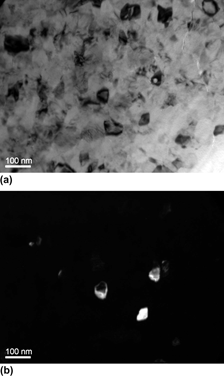No CrossRef data available.
Article contents
Nanoscale structure of Ti1−xNbyO2 mixed-phase thin films: Distribution of crystal phase and dopants
Published online by Cambridge University Press: 23 January 2012
Abstract

Transmission electron microscopy (polycrystalline electron diffraction, nanoelectron diffraction, and energy dispersive x-ray spectroscopy) was used to determine the dispersion of crystal phase and Nb dopants in mixed-phase (anatase and rutile) Ti1−xNbyO2 thin films prepared by reactive sputtering. When co-sputtering mixed-phase TiO2 with a dopant, it is unclear how the crystal phases are distributed within thin film structures, what the dominant interfaces are, and how the dopant is distributed within the crystal phases. In the Ti1−xNbyO2 films, anatase and rutile grains were found to be homogeneously dispersed indicating that anatase/rutile interfaces are the dominant interfaces. Anatase/rutile interfaces are a critical feature of mixed-phase materials which impart high reactivity to the composite. Nb homogeneously dispersed at low concentrations, but at high concentrations, Nb segregated in the rutile phase. There is an apparent threshold beyond which Nb segregates according to its higher solubility in rutile due to a better lattice fit.
Keywords
- Type
- Articles
- Information
- Copyright
- Copyright © Materials Research Society 2012




